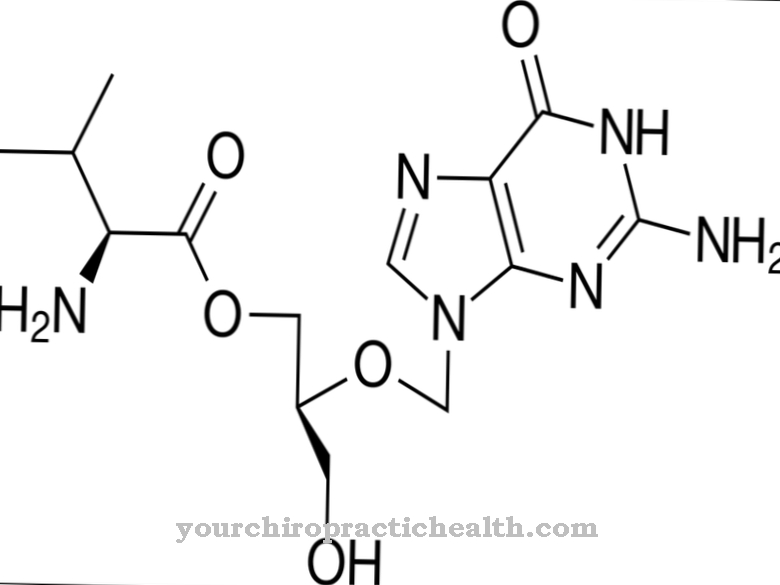With the active ingredient Perphenazine it is a highly potent neuroleptic. It is used to treat delusions, hallucinations and psychoses.
What is perphenazine?
Perphenazine is part of the phenothiazine group of drugs. The active ingredient was developed in the 1950s. It came onto the market in 1957 and was sold in Germany as a monopreparation under the trade name Decentan®.
Nowadays, perphenazine is used less often, as more modern neuroleptics are now available.
Pharmacological effect
Perphenazine develops its effect primarily in psychoses. In most cases, these are caused by metabolic disorders in the brain. It is believed that these disorders are responsible for increased excitability in different areas of the brain. These active centers cause, for example, restlessness, fears and delusions. The neurotransmitter dopamine plays an important role in this.
Perphenazine is assigned to the neuroleptics that have a depressant effect on the human nervous system. It is one of the phenothiazines that have the effect of classic neuroleptics. In this way, the medicinal substance influences the interaction between the different nerve cells and their interconnections. Perphenazine acts as an antagonist to dopamine, whose binding sites are blocked by it.
Perphenazine is not only powerful but also works quickly. Its dopamine-inhibiting effect dampens symptoms caused by psychosis, as well as nervousness and restlessness. Animal experiments have shown that perphenazine has stronger effects than chlorpromazine. The neuroleptic mode of action can be compared with haloperidol.
If perphenazine is used in higher doses, the messenger substances adrenaline and histamine, which influence the autonomic nervous system, are also inhibited. In this way, movement disorders can be reduced, which are among the symptoms of schizophrenic psychosis.
In addition, the neuroleptic affects the messenger substance acetylcholine. This neurotransmitter is important for moving muscles. The effect of perphenazine can reduce muscle twitching that occurs during psychotic attacks.
Due to the influence on acetylcholine, the activity of the intestine and the flow of saliva are also stimulated. For this reason, the drug is also considered effective against nausea and vomiting.
Perphenazin's bioavailability is 40 percent, while the plasma half-life is between 8 and 12 hours. The metabolism of the neuroleptic takes place via the liver.
Medical application & use
Perphenazine is mainly used in the treatment of psychotic disorders such as acute psychosis. The neuroleptic has a soothing effect on strong mood swings that occur in the context of manias, hallucinations and delusions. These mostly come about through a psychotic surge.
Perphenazine also serves to relieve pronounced muscle twitching during an acute attack of schizophrenia. Schizophrenia is one of the most common forms of psychosis. Since the neuroleptic also has calming properties, it can also be administered against nervousness.
Perphenazine is also used for nausea and vomiting, for which it is given as an alternative. This means that other means for this purpose were not previously effective.
The drug is administered by taking tablets or drops. It can also be administered as an injection solution in an ampoule. The recommended dose of perphenazine is 4 to 8 milligrams, given up to three times a day. The agent is also suitable for long-term therapy, which, however, increases the risk of tardive dyskinesia.
You can find your medication here
➔ Medicines to calm down and strengthen nervesRisks & side effects
The use of perphenazine can cause undesirable side effects. The most common side effects include drowsiness, insomnia, drowsiness, tiredness, dizziness, restlessness, dyskinesia (involuntary head movements), jerking the tongue out, movement disorders, stiffness of the muscles, involuntary movements in the face, tremors and sedentary lifestyle.
Other common side effects are orthostatic disorders of the circulatory regulation, cardiac arrhythmias, increased heartbeat, low blood pressure, an increase in the prolactin level in the blood, tension in the breasts, menstrual disorders and milk flow, bronchial asthma, impotence and orgasmic disorders.
In some patients, a malignant neuroleptic syndrome sets in during perphenazine therapy, which can assume life-threatening proportions. Muscle stiffness, palpitations, circulatory collapse, fever, high blood pressure and clouded consciousness are noticeable. Even falling into a coma is possible. At the beginning of the treatment, muscle spasms may appear in the arms, neck, mouth and face, which in turn affects facial expressions.
If the patient is hypersensitive to perphenazine or other phenothiazines, the drug must not be used. The same applies after acute poisoning with alcohol, sleeping pills or pain medication.
The doctor must carefully weigh up the treatment with perphenazine if the patient has severe liver dysfunction, pre-existing cardiac damage, diseases of the blood and bone marrow, breast cancer, a tumor in the pituitary gland, orthostatic circulatory disorders, asthma, persistent breathing difficulties, depression or narrowing of the stomach. Intestinal tract suffers. The same applies to the presence of convulsions such as epilepsy. If there is an overactive thyroid, the doctor should carefully monitor the patient.
If perphenazine is considered during pregnancy, it is important for the doctor to weigh the benefits and dangers of the treatment. Animal experiments showed damage to the child when using the active ingredient, so that the agent should only be taken in exceptional cases. Because perphenazine also passes into breast milk and has a harmful effect on the child, breastfeeding must be avoided during therapy.

















.jpg)







.jpg)


